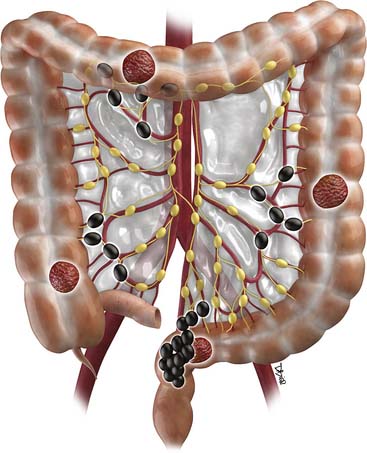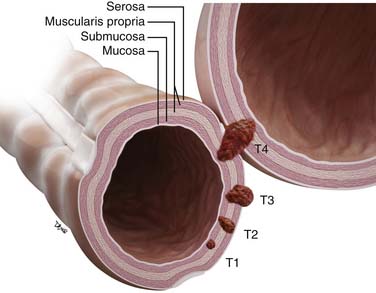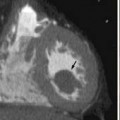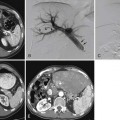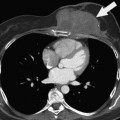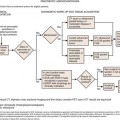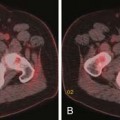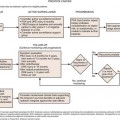Chapter 17 Colorectal Cancer
Introduction*
Colorectal cancer (CRC) is one of the most common adult cancers.1 Imaging plays an important role in the management of CRC, including screening, staging, and surveillance. Understanding the anatomy of the colon and rectum is important when interpreting radiologic examinations pertaining to CRC. This especially applies when evaluating for the pattern and extent of disease spread.
Double-contrast barium enema (DCBE) and computed tomographic colonography (CTC) are recommended imaging screening tests for CRC.2 Staging involves accurate depiction of disease based on the tumor, node, and metastasis (TNM) classification system. Endoscopic ultrasound (EUS) plays an important role in the staging of rectal cancer. Advancements in miniprobe examination may increase its role for the more proximal cancers.3 Computed tomography (CT) remains the mainstay for CRC imaging owing to its widespread availability. Its value lies more in the assessment of nodal and distant disease rather than of the primary tumor itself. Magnetic resonance imaging (MRI), with its superior soft tissue resolution capability, has a role for both primary evaluation of rectal cancers and assessment of distant metastatic disease in the liver.4 Positron-emission tomography (PET)/CT provides both functional and anatomic information. It allows for whole body assessment in a single examination, making it valuable for detection of unsuspected sites of disease.
Surveillance by imaging is usually carried out in tandem with serum carcinoembryonic antigen (CEA) assays. In the appropriate setting, surgical resection of locally recurrent disease in the pelvis as well as metastatic disease in the liver and lungs has been shown to improve survival.5,6 Therefore, when CEA levels show a rise during postoperative surveillance, it is important to identify the presence and location of recurrent and distant disease to allow for prompt treatment. PET/CT has emerged as an indispensable modality in this regard, and its use has increased tremendously since its introduction in 2001.
Epidemiology and Risk Factors
Approximately 1 in 19 men and women will be diagnosed with cancer of the colon and rectum during their lifetime.1 In the United States, CRC is the second leading cause of death from cancer, with an estimated 50,000 cases in 2009.7 The majority of CRC patients are older than age 50, with relatively equal gender incidence.4 Recent declines in CRC incidence and mortality are attributable to reduced risk factor exposure, early detection and prevention through polypectomy, and improved treatment.8
Most CRCs develop from adenomatous polyps through a process known as the adenoma-carcinoma sequence. Malignant potential of a polyp increases with size. Polyps smaller than 0.5 cm have virtually no risk, whereas those greater than 2 cm have a 40% risk for invasive carcinoma.9 Although previously thought to be benign, the serrated form of hyperplastic colonic polyps have recently been shown to be associated with malignant transformation.10
The most common form of hereditary CRC is hereditary nonpolyposis CRC (Lynch’s syndrome). Others include familial adenomatous polyposis (FAP), juvenile polyposis, and Peutz-Jeghers.11 Specific genetic mutations linked to CRC include p53, APC, and K-ras mutations.12 With inflammatory bowel disease (ulcerative colitis or Crohn’s disease), the risk of CRC increases with duration and anatomic extent of colitis, degree of inflammation, and concomitant family history of CRC.13 Dietary and lifestyle factors that have been implicated as risk factors include obesity, hyperglycemia, consumption of red and processed meat and animal fat, and high alcohol intake.14,15
Anatomy and Pathology
The large intestine is about 1.5 m long, being one fifth of the whole extent of the intestinal canal. The large intestine is divided into the cecum, colon, rectum, and anal canal. It is generally accepted that tumors with epicenters located more than 2 cm proximal to the dentate line are rectal, whereas those that are distal to this are considered anal.16 This distinction is important for staging. Based on the American Joint Committee on Cancer (AJCC) staging system, the T stage of CRC is determined by degree of involvement of the bowel wall whereas that of the anus is determined by the size of the primary tumor. Also, the N stage of CRC is defined by the number of involved nodes, as opposed to the location of nodes in anal cancer.
Tumor size has not been shown to carry prognostic significance in CRC.17,18 Other than the prognostic indicators defined by the AJCC staging system (which are discussed in the “Staging” section, later), histologic subtype, tumor grade, lymphovascular involvement, tumor border invasion, and host lymphoid response to tumor also affect prognosis.
The World Health Organization (WHO) classifies the CRCs into the following: adenocarcinoma, medullary, mucinous (colloid) adenocarcinoma (>50% mucinous), signet-ring cell carcinoma (>50% signet-ring cells), squamous cell (epidermoid) carcinoma, adenosquamous carcinoma, small cell (oat cell) carcinoma, undifferentiated carcinoma, and others (e.g., papillary carcinoma). Adenocarcinomas make up more than 95% of colorectal primaries. Of the remaining primaries, neuroendocrine (1.8%), lymphoma (0.6%), squamous cell carcinoma (0.3%), and sarcoma (<0.1%) are considered rare. Among the histologic subtypes of CRC, carcinoid and neuroendocrine carcinoma show the best and the worst relative 5-year survival rates, respectively. Also, both malignant lymphoma and squamous cell carcinoma patients have significantly worse overall 5-year and early-stage (localized and regional) survival rates than adenocarcinoma.19 The signet-ring cell type of adenocarcinoma and small cell (oat cell) carcinoma are the only histologic types of colonic carcinoma that consistently have been found to have a stage-independent adverse effect on prognosis. The prognostic significance of mucinous carcinoma remains controversial. Conversely, medullary carcinoma is prognostically favorable.20
In terms of tumor grade, a two-tier system of low- (well- and moderately differentiated) and high- (poorly and undifferentiated) grade tumors has been proposed to reduce interobserver variability.17 Multivariate analysis has also shown the presence of lymphovascular invasion to be an adverse prognostic indicator.17,18,20 The configuration of the tumor at the advancing edge (irregular and infiltrating pattern) has been shown to be an independent adverse prognostic factor as well. In contrast, the presence of lymphocytic infiltration of tumor or peritumoral tissue at pathology implies a host immunologic response to the tumor and, therefore, is a favorable prognostic factor. Use of molecular markers as prognostic indicators is currently still the subject of research and no known marker has been validated for routine patient care.16
Clinical Presentation
Symptoms commonly associated with CRC include abdominal pain, change in bowel habits, hematochezia or anemia, weakness or malaise, and weight loss.21,22 Symptoms depend on tumor size and location. The left colonic lumen has a smaller caliber than the right and contains better-formed stool owing to water absorption by the proximal colon. This explains why left-sided colonic cancers have a higher chance of causing obstructive symptoms and change in bowel habits. This may also be seen in bulky exophytic tumors.23 Distal tumors can cause rectal bleeding, whereas proximal tumors are more likely to result in occult bleeding and symptoms of anemia.
Clinical signs do not manifest until late in disease.24 The primary mass rarely presents as an abdominal mass.25 Digital rectal examination may reveal the presence of a low rectal tumor. Systemic effects of malignancy include muscular wasting and hypoalbuminemia (manifests as anasarca in severe cases). Hepatomegaly and enlarged Virchow’s (supraclavicular) lymph node may be encountered in bulky metastatic disease. Iron deficiency anemia results from gastrointestinal bleeding, with stigmata such as koilonychia, cheilitis, and pallor.
Although elevated serum CEA levels are often present in CRC they are of little use in detecting early CRC and, therefore, are not a recommended tool for screening asymptomatic patients.26 The accuracies of fecal occult blood tests (FOBTs) and fecal immunochemical tests (FITs) depend on the frequency of testing, specimen collection, and analysis technique.27 For the detection of occult gastrointestinal bleeding, brush-sampling FIT has been shown to be more sensitive than guaiac-based FOBT.28 Newer methods that detect DNA mutations in the stool (sDNA) may be more specific but require validation.29 The current American Cancer Society guidelines for CRC screening are presented in Table 17-1.
Table 17-1 Testing Options for the Early Detection of Colorectal Cancer and Adenomatous Polyps for Asymptomatic Adults Aged 50 Years and Older
| TESTS THAT DETECT ADENOMATOUS POLYPS AND CANCER |
|---|
| Flexible sigmoidoscopy every 5 yr, or Colonoscopy every 10 yr, or Double-contrast barium enema every 5 yr, or Computed tomographic colonography every 5 yr |
| Tests that Primarily Detect Cancer |
| Annual guaiac-based fecal occult blood test with high test sensitivity for cancer, or Annual fecal immunochemical test with high test sensitivity for cancer, or Stool DNA test with high sensitivity for cancer, interval uncertain |
Adapted from Levin B, Lieberman DA, McFarland B, et al; American Cancer Society Colorectal Cancer Advisory Group; US Multi-Society Task Force; American College of Radiology Colon Cancer Committee. Screening and surveillance for the early detection of colorectal cancer and adenomatous polyps, 2008: a joint guideline from the American Cancer Society, the US Multi-Society Task Force on Colorectal Cancer, and the American College of Radiology. Gastroenterology. 2008;134:1570-1595.
Patterns of Tumor Spread
Local Spread
Locally, tumor can spread either intramurally or transmurally. Intramural spread of tumor can occur longitudinally along the bowel wall or superficially toward the serosa. Tumor preferentially grows circumferentially, resulting in luminal narrowing. Longitudinal spread is not common and is generally approximately 2 cm from the primary site of disease. This supports the practice of a 5-cm surgical margin.30 Transmural spread is present in more advanced tumors. The depth of invasion within the bowel wall determines prognosis, as detailed in standard staging classification systems (see section on “Staging,” later). The ascending colon, descending colon, and rectum, which are primarily retroperitoneal in location, can directly invade the adjacent retroperitoneal organs such as the kidneys and pancreas via this mode of spread. Locally advanced rectal cancer often involves the pelvic viscera including the bladder base, prostate gland, and vagina.31 These may present with rectovaginal or rectovesical fistulas. Invasion of adjacent organs depends upon the site of primary tumor and mandates en bloc resection to achieve curative surgery.32
Disease can also spread along the neurovascular structures. Extramural venous invasion is associated with increased metastastic burden and poorer overall prognosis. This has been shown in multiple studies (see section on “Imaging,” later). Perineural spread in rectal cancer can result in tumor deposits along the perineural spaces more than 10 cm from the primary tumor. This has been reported in as many as 35% of cases.33
Nodal
Distant spread of disease most commonly occurs in the liver, followed by lymph nodes.34 The nodal pathways of spread for CRC are illustrated in Figure 17-1.35 Nodal spread from carcinomas of the right colon follow along the marginal vessels of the cecum and ascending colon and then along the ileocolic vessels to the root of the superior mesenteric artery. Tumors of the proximal transverse colon tend to spread along the marginal vessels on the mesocolic side of the colon. These marginal vessels in turn drain to the right or middle colic vessels and to the root of the mesocolon, anterior to the head of the pancreas. Lymphatics from the distal transverse colon and splenic flexure follow the left middle colic vessels to the inferior mesenteric vein just caudal to the body and tail of the pancreas. Cancers of the descending colon and sigmoid colon will spread to nodes along the left ascending colic and sigmoidal vessels that can then be followed to the origin of the inferior mesenteric artery.36 Proximal rectal tumors spread cranially via the superior hemorrhoidal nodes antegradely to the inferior mesenteric lymph nodes. The more distal rectal tumors spread laterally along the internal iliac lymph nodes antegradely to the common iliac and retroperitoneal chains. Those located at the rectosigmoid junction tend to spread to the perirectal lymph nodes rather than along the sigmoid mesenteric chain.37
Peritoneal
Peritoneal spread of disease is seen in up to 43% of patients.31 Tumor cells can spread throughout the peritoneal cavity and implant on the omentum and peritoneal surfaces. This pattern of spread is seen more commonly in the intraperitoneal portions of the colon, including the cecum and transverse and sigmoid colon.31 The ovaries are a common site of involvement by peritoneal dissemination.30 In animal models, injection of neoplastic cells into the mesenteric border tend to give rise to nodal metastases whereas injection into the antimesenteric border gives rise to peritoneal metastases, alluding to the role of tumor location to the method of dissemination.38 The presence of peritoneal involvement predicts for higher local recurrence and is strongly associated with a mucinous tumor phenotype (signet-ring feature).39
Hematogenous
Ten percent to 25% of patients harbor detectable metastases at the time of initial diagnosis.40 Hematogeneous spread of colonic and upper rectal tumors initially occur via the portal circulation. The liver is often the first site of metastatic disease and may be the only site of spread in as many as 30% to 40% of patients with advanced disease.41 Twenty percent to 25% of patients will have clinically detectable liver metastases at the time of the initial diagnosis and a further 40% to 50% of patients will eventually develop liver metastases after resection of the primary. Approximately 20% to 30% of patients with metastatic CRC have disease that is confined to the liver and is potentially resectable.42 In low rectal tumors, venous drainage occurs through the systemic circulation via the iliac vessels. This may explain the higher propensity of pulmonary metastases in low rectal cancers compared with tumors from the more proximal parts of the colon and rectum.31 In the appropriate clinical setting, aggressive surgical resection of distant metastases (including the liver, lung, adrenal gland, and spleen) has been shown to confer survival benefit.43 Therefore, early detection of metastastic disease by imaging is important.
Key Points Tumor Spread
• CRCs can spread locally or through lymphatic, peritoneal, and hematogenous routes.
• Nodal disease has predictable spread.
• Peritoneal disease occurs in up to 43% in patients, is a predictor of local recurrence and mucinous histology. There is 10% to 25% hematogenous spread at diagnosis
• CRCs can spread locally or through lymphatic, peritoneal, and hematogenous routes.
Staging
The TNM staging system of the AJCC and the International Union Against Cancer (UICC) is currently the standard for CRC staging recommended by the National Cancer Institute and tumor registries worldwide.44,45
Clinical classification (cTNM) is based on clinical, radiologic, and surgical information. Pathologic classification (pTNM) is based on a previously untreated primary tumor. cTNM, once assigned, is not changed on the basis of subsequent information, even when pTNM becomes available and may be considered more accurate.44 The posttreatment status of the tumor (yTNM) carries prognostic importance as well. For multiple synchronous tumors, the lesion with the highest T category determines the stage.
Because the TNM staging is applicable only to primary carcinomas of the colon and rectum, other tumors such as colorectal lymphomas, carcinoid tumors, and metastases are excluded.46 The staging classification is summarized in Figure 17-2.
T Stage
Tis (carcinoma in situ) refers to disease that is superficial to the muscularis mucosa. Penetration of the muscularis mucosa and invasion of the submucosa is classified as T1. CRC that has penetrated into, but not completely through, the muscularis propria is classified as T2.
T3 disease includes all transmurally invasive tumors confined to the perimuscular soft tissue (i.e., that have neither violated the serosal surface nor infiltrated an adjacent structure).47 Extramural tumor nodules discontinuous from the primary tumor mass that are irregular in shape are also included.47 Nodules with smooth contours are regarded as lymph nodes.
Direct invasion of adjacent organs or structures or other segments of the colorectum by way of the serosa or mesocolon (e.g., invasion of the sigmoid colon by carcinoma of the cecum) is classified as T4 disease. Intramural (longitudinal) extension of tumor from one subsite (segment) of the large intestine into an adjacent subsite (either the terminal ileum or the anal canal) does not affect the T classification.47 Serosal penetration (T4b disease) is associated with significantly shorter median survival time than T4 tumors without serosal involvement (T4a disease).47 The prognostic significance of this may supersede even that of regional lymph node metastasis (N category).48
N Stage
The definition of regional nodes is covered in Table 17-2. Because it has been shown that many nodal metastases in CRC are found in small lymph nodes (<5 mm in diameter), a minimum of 12 lymph nodes is considered adequate for curative surgical resection.49–51 Regional nodal involvement is classified as N disease (see Table 17-2), whereas all other nodal metastases are classified as M1. As mentioned, extramural tumor nodules of smooth contours are regarded as replaced regional lymph nodes.44,45,47 The number of pericolonic tumor deposits has been shown to correlate inversely with disease-free survival.52
Table 17-2 Definitions of Regional Lymph Node Groups in Anatomic Subsites of the Colon and Rectum
| COLON AND RECTUM SUBSITE | DEFINITION |
|---|---|
| Cecum | Anterior cecal, posterior cecal, ileocolic, right colic |
| Ascending colon | Ileocolic, right colic, middle colic |
| Hepatic flexure | Middle colic, right colic |
| Transverse colon | Middle colic |
| Splenic flexure | Middle colic, left colic, inferior mesenteric |
| Descending colon | Left colic, inferior mesenteric, sigmoid |
| Sigmoid colon | Inferior mesenteric, superior rectal sigmoidal, sigmoid mesenteric* |
| Rectosigmoid colon | Perirectal,† left colic, sigmoid mesenteric, sigmoidal, inferior mesenteric, superior rectal, middle rectal |
| Rectum | Perirectal,† sigmoid mesenteric, inferior mesenteric, lateral sacral, presacral, internal iliac, sacral promontory, superior rectal, middle rectal, inferior rectal |
* Lymph nodes along the sigmoid arteries are considered pericolic nodes, and their involvement is classified as pN1 or pN2 according to the number involved.
† Perirectal lymph nodes include the mesorectal (paraproctal), lateral sacral, presacral, sacral promontory (Gerota), middle rectal (hemorrhoidal), and inferior rectal (hemorrhoidal) nodes. Metastasis in the external iliac or common iliac nodes is classified as pM1.
Adapted from Compton CC, Greene FL. The staging of colorectal cancer: 2004 and beyond. CA Cancer J Clin. 2004;54:295-308.
In rare cases, the regional nodes of the primary tumor site are free of malignancy but the nodes in the drainage area of an organ directly invaded by the primary tumor contain metastases. When this occurs, the lymph nodes of the invaded site are considered as those of the primary site and are also classified under the N category.47
Isolated tumor cells (ITCs) are defined as tumor cells measuring 0.2 mm or less. According to current recommendations, ITCs are classified as N0 or M0, as appropriate.44,47,53 The biologic significance of ITCs is unknown.54 In contrast, metastatic tumors that measure greater than 0.2 mm but less than 2.0 mm are defined as micrometastases and classified as N1 or M1.
Surgical Resection Margin
The pertinent margins of a CRC resection specimen include the proximal and distal transverse margins, the mesenteric margin, and in rectal tumors, the circumferential margin. When the distance between the tumor and the nearest transverse margin is 5 cm or more, anastomotic recurrences are very rare.55 For rectal tumors in which sphincter preservation is an important consideration, a margin of 2 cm is accepted as adequate, especially for T1 and T2 tumors.
The circumferential resection margin (CRM) is defined by the distance between the retroperitoneal or the peritoneal adventitial soft tissue margin closest to the furthest advancing edge of the tumor. This applies to all segments of the large intestine that are either incompletely encased (ascending colon, descending colon, upper rectum) or not encased (lower rectum) by peritoneum. Multivariate analyses have suggested that tumor involvement of the CRM is the most critical factor in predicting local recurrence in rectal cancer.56,57 Emerging data on CRM involvement in the colon suggest likewise.56
Based on published data from clinical trials, the risk of local recurrence is strongly increased if the CRM is less than 1 mm.57 Thus, the current recommendation is for a clearance of 2 mm or less to be considered a positive CRM.58 Currently, if a tumor is present on a peritonealized surface, it is categorized as T4 but may not require adjuvant radiation if the resection margins (including the CRM) are free of tumor (R0). However, if a tumor is present on a nonperitonealized surface (i.e., the CRM), adjuvant radiation may be appropriate irrespective of the T category of the tumor.46
Key Points Staging
• The CRM is defined by the distance between the retroperitoneal or the peritoneal adventitial soft tissue margin closest to the furthest advancing edge of the tumor.
• Serosal penetration (T4b) associated with shot survival times metastases is not uncommon in even small nodes; therefore, minimum resection for cure should include 12 nodes.
Lymphovascular Invasion
Venous invasion by tumor has been demonstrated repeatedly to be a stage-independent adverse prognostic factor by either multivariate or univariate analyses.59–62 Mixed results have also been reported for lymphatic invasion, although the general consensus is that lymphovascular invasion is a negative prognostic factor.63,64 Interestingly, the presence of tumor cells within the lymphatics or veins does not affect the T stage. Intravascular spread via lymphatic or venous vessels is classified as L1 and V1, respectively. Tumor within the lymphatics of a distant organ is classified as M1 disease.
Imaging
Screening
Double-Contrast Barium Examination
Five-yearly DCBE is acceptable for screening, even though use of DCBE is on the decline. Most studies evaluating DCBE are limited in that they are retrospective reviews of known CRC patients for prior DCBE. DCBE has sensitivity of between 85% and 97% for cancer.2 Sensitivity decreases with lesion size. In symptomatic patients, for lesions more than 1 cm in size, the reported sensitivities are 75% to 90%, whereas those smaller than 1 cm range from 50% to 80%.65,66 For asymptomatic patients, lower sensitivity rates of 48% and 32%, respectively, are reported.67 There have been no randomized, controlled trials evaluating the efficacy of DCBE as a primary screening modality to reduce incidence or mortality from CRC.2
The advantages of DCBE is that it provides screening for the whole colon and is relatively safe, with a perforation rate of 1 in 25,000 and an associated mortality rate of 1 in 250,000,68 compared with 1 in 1000 patients undergoing colonoscopy.69 The disadvantages of DCBE include need for rigorous bowel preparation, discomfort during the procedure, and operator and reader dependency on interpretation of results.
Computed Tomography Colonography
The ACRIN (American College of Radiology Imaging Network) National CT Colonography Trial, which studied 2500 patients across 15 institutions in the United States, has shown comparable accuracy between CTC and standard colonoscopy.70 Using fecal tagging and primary 3D polyp detection in asymptomatic adults, Pickhardt and coworkers71 reported a sensitivity of 89% for adenomas 6 mm or larger. For invasive CRC, the pooled CTC sensitivity was higher at 96%. As with other screening techniques, CTC accuracy improves with lesion size. Other than detection, consistent polyp size measurement is important because it will influence referrals for polypectomy. Use of 3D reconstructed images or 2D assessment in the lung window is recommended for accurate polyp size measurement.72 All patients with one or more polyps 10 mm or larger or three or more polyps 6 mm or larger should be referred for colonoscopy.73 The management of patients with fewer polyps (<3) in which the largest is 6 to 9 mm or smaller remains controversial.74,75
The main drawback of CTC is radiation exposure. One CTC study in a 50 year old results in an estimated organ dose to the colon of 7 to 13 mSv, an additional 0.044% to the lifetime risk of colon cancer.76 More efficient low-dose protocols have demonstrated decreased estimated organ dose ranges of 5 to 8 mSv.77 The risk for colonic perforation during screening is extremely low, 0.005% for asymptomatic patients and higher for symptomatic patients (0.03-0.06%), and may be safer with carbon dioxide delivery rather than with room air.78,79
Cancer Evaluation
Plain Radiography
Plain films have little role in the diagnosis of CRC, except to demonstrate acute complications of obstruction or perforation. In bowel obstruction, isolated dilatation of the colon is unusual. More commonly, both the small and the large bowels are dilated. If the ileocecal valve is patent, small bowel dilatation only may manifest, due to decompression of air retrogradely from the proximal colon. Rarely, a soft tissue mass may be visualized, although additional imaging is often required to confirm the diagnosis. In the mucus-secreting (colloid) variant, calcified liver or nodal metastases may be evident. These are usually associated with a poor prognosis.80
Endoscopic Ultrasound
The role of EUS is largely confined to local staging for rectal cancer because more proximal tumors are difficult to assess with the rigid probe, although this may change with the use of the miniprobe ultrasound examination.3
EUS provides accurate depiction of the rectal wall layers. Most practices use a 7.5- or 10-MHz rigid transducer with a saline-filled balloon tip, allowing a 360-degree field of view. Tumor most commonly appears as a hypoechoeic mass disrupting the rectal wall layers.3 Early rectal cancer is demonstrated by tumor ingrowth into the superficial layers of the rectal wall, with staging accuracy ranging from 69% to 97%.81,82 A meta-analysis by Bipat and colleagues,83 comparing CT, EUS, and MRI, showed that endorectal ultrasound may be the imaging modality of choice for rectal cancer.
Owing to the similar appearances between peritumoral inflammatory changes and extramural extension, overstaging T2 tumors as T3 tumors is common.84 Perirectal nodal involvement is also limited. Bipat and colleagues83 showed overall sensitivity of 67% and specificity of 78% for nodal involvement. This is related to its limited acoustic window, depth of penetration, and small field of view, which also limits evaluation of the distance between the tumor and the mesorectal fascia. Operator dependence, need for bowel preparation, and intraprocedural pain due to stenotic lesions are other limitations.
Stay updated, free articles. Join our Telegram channel

Full access? Get Clinical Tree


